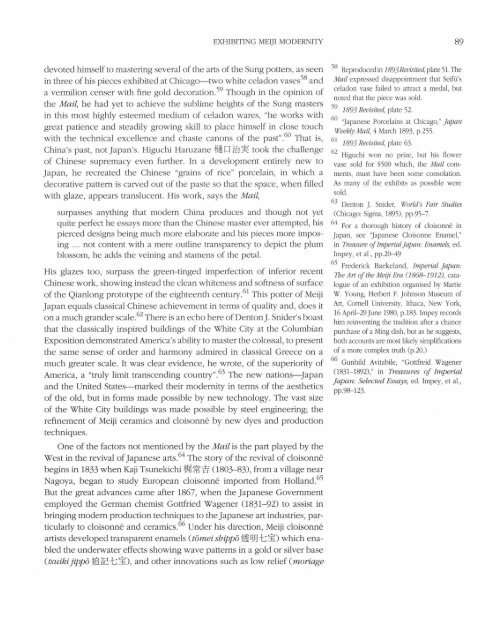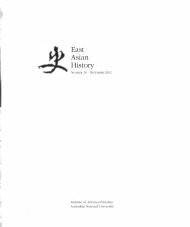Exhibiting Meiji Modernity: Japanese Art at the ... - East Asian History
Exhibiting Meiji Modernity: Japanese Art at the ... - East Asian History
Exhibiting Meiji Modernity: Japanese Art at the ... - East Asian History
- No tags were found...
Create successful ePaper yourself
Turn your PDF publications into a flip-book with our unique Google optimized e-Paper software.
EXHIBITING MEIJI MODERNITY<br />
89<br />
devoted himself to mastering several of <strong>the</strong> arts of <strong>the</strong> Sung potters, as seen<br />
in three of his pieces exhibited <strong>at</strong> Chicago-two white celadon vases 58 and<br />
a vermilion censer with fine gold decor<strong>at</strong>ion. 59 Though in <strong>the</strong> opinion of<br />
<strong>the</strong> Mail, he had yet to achieve <strong>the</strong> sublime heights of <strong>the</strong> Sung masters<br />
in this most highly esteemed medium of celadon wares, "he works with<br />
gre<strong>at</strong> p<strong>at</strong>ience and steadily growing skill to place himself in close touch<br />
with <strong>the</strong> technical excellence and chaste canons of <strong>the</strong> past,,60 Th<strong>at</strong> is,<br />
China's past, not Japan's. Higuchi Haruzane mr Q m~ took <strong>the</strong> challenge<br />
of Chinese supremacy even fur<strong>the</strong>r. In a development entirely new to<br />
Japan, he recre<strong>at</strong>ed <strong>the</strong> Chinese "grains of rice" porcelain, in which a<br />
decor<strong>at</strong>ive p<strong>at</strong>tern is carved out of <strong>the</strong> paste so th<strong>at</strong> <strong>the</strong> space, when filled<br />
with glaze, appears translucent. His work, says <strong>the</strong> Mail,<br />
surpasses anything th<strong>at</strong> modern China produces and though not yet<br />
quite perfect he essays more than <strong>the</strong> Chinese master ever <strong>at</strong>tempted, his<br />
pierced designs being much more elabor<strong>at</strong>e and his pieces more imposing<br />
... not content with a mere outline transparency to depict <strong>the</strong> plum<br />
blossom, he adds <strong>the</strong> veining and stamens of <strong>the</strong> petal.<br />
His glazes too, surpass <strong>the</strong> green-tinged imperfection of inferior recent<br />
Chinese work, showing instead <strong>the</strong> clean whiteness and softness of surface<br />
of <strong>the</strong> Qianlong prototype of <strong>the</strong> eighteenth century61 This potter of <strong>Meiji</strong><br />
Japan equals classical Chinese achievement in terms of quality and, does it<br />
on a much grander scale. 62 There is an echo here of DentonJ. Snider's boast<br />
th<strong>at</strong> <strong>the</strong> classically inspired buildings of <strong>the</strong> White City <strong>at</strong> <strong>the</strong> Columbian<br />
Exposition demonstr<strong>at</strong>ed America's ability to master <strong>the</strong> colossal, to present<br />
<strong>the</strong> same sense of order and harmony admired in classical Greece on a<br />
much gre<strong>at</strong>er scale. It was clear evidence, he wrote, of <strong>the</strong> superiority of<br />
America, a "truly limit transcending country".63 The new n<strong>at</strong>ions-japan<br />
and <strong>the</strong> United St<strong>at</strong>es-marked <strong>the</strong>ir modernity in terms of <strong>the</strong> aes<strong>the</strong>tics<br />
of <strong>the</strong> old, but in forms made possible by new technology. The vast size<br />
of <strong>the</strong> White City buildings was made possible by steel engineering; <strong>the</strong><br />
refinement of <strong>Meiji</strong> ceramics and cloisonne by new dyes and production<br />
techniques.<br />
One of <strong>the</strong> factors not mentioned by <strong>the</strong> Mail is <strong>the</strong> part played by <strong>the</strong><br />
West in <strong>the</strong> revival of <strong>Japanese</strong> arts. 64 The story of <strong>the</strong> revival of cloisonne<br />
begins in 1833 when Kaji Tsunekichi flt'i¥;i5 (1803-83), from a village near<br />
Nagoya, began to study European cloisonne imported from Holland. 65<br />
But <strong>the</strong> gre<strong>at</strong> advances came after 1867, when <strong>the</strong> <strong>Japanese</strong> Government<br />
employed <strong>the</strong> German chemist Gottfried Wagener (1831-92) to assist in<br />
bringing modern production techniques to <strong>the</strong> <strong>Japanese</strong> art industries, particularly<br />
to cloisonne and ceramics. 66 Under his direction, <strong>Meiji</strong> cloisonne<br />
artists developed transparent enamels (tomei shippo mBJlt3D which enabled<br />
<strong>the</strong> underw<strong>at</strong>er effects showing wave p<strong>at</strong>terns in a gold or silver base<br />
(tsuikijippo ~~ct3D, and o<strong>the</strong>r innov<strong>at</strong>ions such as low relief (mariage<br />
58 Reproduced in 1893 Revisited, pl<strong>at</strong>e 51. The<br />
Mail expressed disappointment th<strong>at</strong> SeifCi's<br />
celadon vase failed to <strong>at</strong>tract a medal, but<br />
noted th<strong>at</strong> <strong>the</strong> piece was sold.<br />
59 1893 Revisited, pl<strong>at</strong>e 52.<br />
60 "<strong>Japanese</strong> Porcelains <strong>at</strong> Chicago," Japan<br />
Weekly Mail, 4 March 1893, p.255.<br />
61 1893 ReVisited, pl<strong>at</strong>e 63.<br />
62 Higuchi won no prize, but his flower<br />
vase sold for $500 which, <strong>the</strong> Mail comments,<br />
must have been some consol<strong>at</strong>ion.<br />
As many of <strong>the</strong> exhibits as possible were<br />
sold.<br />
63 Denton ]. Snider, World 's Fair Studies<br />
(Chicago: Sigma, 1895), pp.95-7.<br />
64 For a thorough histolY of cloisonne in<br />
Japan, see "<strong>Japanese</strong> Cloisonne Enamel,"<br />
in Treasure of Imperial Japan: Enamels, ed.<br />
Impey, et aI., pp.20-49<br />
65 Frederick Baekeland, Imperial Japan:<br />
The <strong>Art</strong> of <strong>the</strong> <strong>Meiji</strong> Era (1868-1912), c<strong>at</strong>alogue<br />
of an exhibition organised by Martie<br />
W. Young, Herbert F. Johnson Museum of<br />
<strong>Art</strong>, Cornell University, Ithaca, New York,<br />
16 April-29 June 1980, p.183. Impey records<br />
him reinventing <strong>the</strong> tradition after a chance<br />
purchase of a Ming dish, but as he suggests,<br />
both accounts are most likely simplific<strong>at</strong>ions<br />
of a more complex truth (p.20.)<br />
66 Gunhild Avitabile, "Gottfreid Wagener<br />
(1831-1892)," in Treasures of Imperial<br />
Japan: Selected Essays, ed. Impey, et al.,<br />
pp.98-123.
















